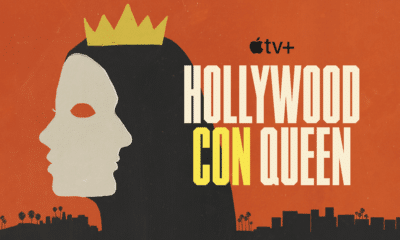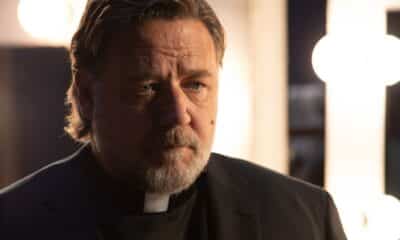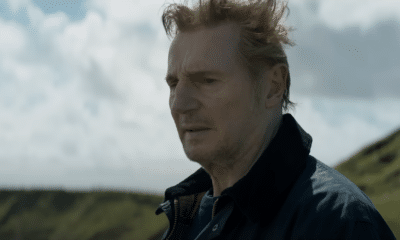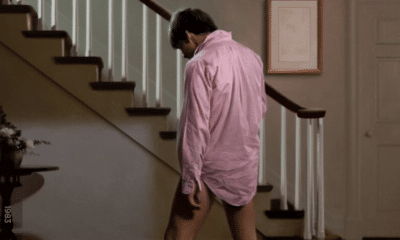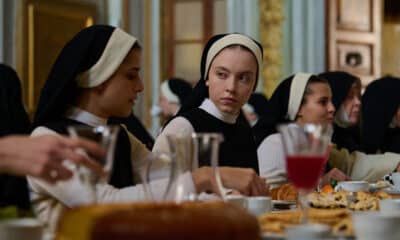Throughout the year, THN will look at 53 Walt Disney Animated Classics, from SNOW WHITE to WRECK-IT RALPH, through the obscurity of FUN AND FANCY FREE to the second Golden Age of BEAUTY AND THE BEAST. These are the films the Walt Disney company are most proud of, the ones that hold a special place in our hearts, the ones that still cost a fortune to buy on DVD.
In the second part of this week’s double hitter, we look for some bear necessities with THE JUNGLE BOOK.
Directed by Wolfgang Reitherman
1967/ 78 minutes
THE JUNGLE BOOK marked a return of sorts for Walt Disney; after only being partially involved in ONE HUNDRED AND ONE DALMATIANS and THE SWORD IN THE STONE, the latter’s disappointing performance led Disney to take a more active role in the film’s story. He threw out storyman Bill Peet’s original script, which closely followed the dark drama and life-or-death struggles of Rudyard Kipling’s original book(s) and brought in Larry Clemmons as writer, giving him a copy of the book and telling him not to read it.
While much of Peet’s work was thrown out – and he left not long afterwards – Disney decided to keep the personalities of the characters he’d created, and basically set out to make a fun family movie out of a serious book. As such, THE JUNGLE BOOK is not so much an adaptation of the book as taking characters from the book and ignoring much of what Kipling actually wrote.
What sets THE JUNGLE BOOK apart from a lot of early Disney films is that the design and personality of the characters was at least partly based on the actors lending their voices, many of whom were familiar stars of the era, including comedian Phil Harris as a streetwise, wise cracking Baloo, and singer/songwriter Louis Prima as King Louis, who was actually created for the film as a foil for Baloo. Harris would go on to voice several other characters (mostly of the same mold as Baloo) for subsequent Disney movies.
THE JUNGLE BOOK, being a Reitherman film, utilises an almost ludicrous amount of recycled material, and indeed material that would go on to be recycled in later films.
Walt Disney never saw how successful his adaptation of The Jungle Book was. He died from lung cancer during production. He was cremated in December 1966, and his ashes interred at the Forest Lawn Memorial Park in Glendale, California.
SYNOPSIS: A surprisingly serious opening sequence leads to a narration by Bagheera, who recounts the day he found an abandoned “Man Cub” in a basket deep in the jungles of India. Knowing the little mite won’t survive, he banks on the maternal instincts of a wolf mother who has just had a litter of cubs. The she-wolf indeed decides to adopt the boy.
We pick things up ten years later, and Mowgli has grown up into a weedy little brat with a bowl haircut and a bright orange loincloth; somehow able to walk upright after being raised by quadrupeds for the last decade. In any case, it comes to the attention of the wolf pack that Shere Khan the tiger has returned to this part of the forest. Knowing of Shere Khan’s fear and hatred of Man, and knowing that he will kill anyone who attempts to protect the boy, the Pack decrees that it’s better for everyone if Mowgli is returned to the Man village. Bagheera volunteers to escort him back.
After a run-in with the python, Kaa, Mowgli observes and tries to join in with the Dawn Patrol, a company of elephants led by the blustering and absent-minded Colonel Hathi and his long-suffering wife, Winnifred. An argument with Bagheera leads Mowgli to strike out on his own, only to run into Baloo, the bear. The big-hearted lug soon falls for the brat and promises to take care of him himself, much to Bagheera’s horror.
As Baloo teaches Mowgli a few life lessons, the boy is abducted by a gang of monkeys, who take him to the ancient ruins to meet their king, Louis. To quote Winnie the Pooh, he’s not in the book, and to be honest he doesn’t add much to the story aside from setting up a comedy setpiece; Louis wants Mowgli to teach him how to make fire like a human, but having been raised by wolves, Mowgli doesn’t know how to either. Bagheera and Baloo arrive to rescue Mowgli, and Baloo’s, uh, inventive distraction leads to the near-total destruction of the Temple.
As they lick their wounds while Mowgli sleeps, Bagheera manages to convince Baloo the Man Village is the only safe place for Mowgli. Baloo is heartbroken, but agrees. As he tries his hardest to explain to Mowgli, the boy runs out on him, right into Kaa’s coils.
Bagheera enlists the aid of Colonel Hathi in searching for Mowgli. Their conversation is overheard by Shere Khan himself, whose morning hunt (for Bambi’s Mother, no less, in another cameo. She gets around, doesn’t she?) was disturbed by the elephants’ march.
As Kaa tries to have his wicked way with a hypnotised Mowgli, Shere Khan happens by. While the Tiger is suspicious of the duplicitous serpentes, he leaves him be. However, the distraction is enough for Mowgli to come to his senses and escape.
Mowgli’s wanderings find him in the company of a quartet of vultures; seeing a kindred spirit in the outcast Man-Cub, the Feathered Four do their best to sing Mowgli’s trouble’s away, only for Shere Khan to cut in.
Mowgli stands defiant against Shere Khan, but quickly realises he’s at the wrong end of the food chain. Luckily, Baloo arrives and manages to keep Shere Khan away from the boy, aided by the vultures. A lightning strike sets a nearby tree ablaze, and Mowgli is able to tie a flaming branch to Shere Khan’s tail. Confronted by his greatest fear, Shere Khan flees. The Vultures’ celebrations are cut short by the apparent death of Baloo, and Bagheera beghins (ahem) a heartfelt eulogy. Of course, the big lug is fine and the three are triumphantly reunited.
As they venture closer to the Man Village, Mowgli is puzzled by a new sound on the wind, and goes to investigate. Climbing a tree overlooking a river, he sees a young girl, gathering water from the river and singing as she works (in a surprisingly deep voice). Mowgli is immediately awestruck, and follows her into the Village. Baloo is sad to see him go, but accepts it’s for the best.
LESSONS LEARNED:
1. Sometimes the best thing to do is the last thing you want to do.
2. You can find a friend in the least likely of places.
3. If you want to see your book get a faithful adaptation, don’t let Disney anywhere near it.
THE HEROES
![]()
![]()
![]()
![]()
Here’s where I get a little controversial. While Mowgli is the focus of the story, let’s be honest, it’s Bagheera and Baloo who are the heroes. They’re the ones that do all the heavy lifting in terms of plot, drama, comedy and whatnot, they’re the heart and soul of the film.
Bagheera, voiced by English actor Sebastian Cabot, went on to narrate the Winnie the Pooh series for Disney with the same charm and gentlemanly air. He’s very much the straight man of the double-act, the pragmatist to the idealistic Baloo. Phil Harris brought his own charm, and his own improvised dialogue to Baloo. He’s very much a big brother to Mowgli and quickly takes the boy to his heart. And while he’s the source of a lot of the comedy – which does get tiresome after a while – he’s also the source of the film’s heart.
THE HEROINE?
![]()
Much like THE SWORD IN THE STONE, there are very few female characters seen in the film, and two of them are mute. One of them – Shere Khan’s would-be prey – is lifted from another movie entirely. Actually, thinking about it, Mowgli’s adopted mother and her cubs are basically redressed footage from 101 DALMATIANS.
Winifred, the Colonel’s mate, is pretty much lifted right from DUMBO, and is even voiced by the same actress, Verna Felton, in her last film role (she passed away one day before Walt Disney, during production). Winifred provides some droll commentary on her husband’s attempts to run his platoon, and it’s she that convinces Hathi to help search for Mowgli, but there’s little by way of originality.
The only other female presence is “The Girl”, voiced by then-seventeen-year-old American actress Darleen Carr. This little cock-tease has one scene, right at the end. Much like Louis, she’s not in the original book, but Disney reasoned that having Mowgli fall in love would be a quick and generally believable way of getting him into the Village at the end of the picture.
THE VILLAIN
![]()
![]()
![]()
![]()
It’s a funny thing; for the first hour or so, Shere Khan isn’t even in the film. He’s mentioned several times and often in hushed tones, his looming presence felt by the other jungle dwellers. When he finally does appear, almost literally stalking into frame with no introduction or fanfare, he almost instantly takes command of the film. Despite being rather faithless to his literary counterpart, Shere Khan commands the fear and respect of everyone and everything he encounters, even other predators like Kaa.
This is largely due to George Sander’s performance, with his deep bass voice and the thickest of English accents, overflowing with malevolence and eloquence. It seems almost wrong that his one goal in the film is to kill a young, defenceless boy. Shere Khan could definitely give Scar a run for his money.
HIS FATE? Disappears over the horizon with his tail wrapped around a flaming tree branch.
SIDEKICKS/HENCHMEN
![]()
![]()
![]()
![]()
Much as Bagheera and Baloo are the heroes, Mowgli falls into the category of sidekick. At no point does he really take charge of any situation, and for an idiot ten-year-old you can’t really expect him to. All he wants is to live out his days in the jungle, be it as a wolf or a bear. He effortlessly fits in with most groups he encounters, from the wolf pack to the wake of vultures.
That being said, he is a headstrong little fellow, defiantly claiming he’s not afraid of anyone or anything, even when it’s staring him in the face and about three seconds away from killing him.
Talking of which, I’m not sure Kaa really falls into the Villain or Henchman category either. I’m putting him here as a secondary antagonist, but there’s little to suggest real malice. While Shere Khan is after the boy as part of his vendetta against Mankind, Kaa is just out for a decent meal, and is constantly thwarted.
He does get one of the best songs, though, and Sterling Holloway surpasses himself in the role.
PLOT
![]()
![]()
![]()
It feels unfair to mark the movie as a faithful adaptation; If I did I’m not sure it would score more than one, two if I’m really generous. Like most other Disney films based on a book or a fairy tale, the movie goes off in its own direction, taking the core concept and characters and weaving a fun and thrilling yarn for the whole family to enjoy. Much like the episodic nature of the books, the film rolls easily between setpieces, as Mowgli encounters one character after the other. In many ways it’s a sibling to ALICE IN WONDERLAND, not least due to Sterling Holloway’s involvement.
That said, making the choice to do the story as a straight narrative does the film a service, and helps to keep the otherwise piecemeal storytelling together as a whole, rather than a series of random events.
LAUGHS
![]()
![]()
![]()
![]()
THE JUNGLE BOOK set out to be a fun movie, and it is for the most part. Most of the comedy comes in physical form and generally involves one character or another getting hurt. Kaa’s foiled attempts to get at Mowgli result in a painful fall from a tree which leaves him crumpled and twisted (it’s worth noting that the exact same animation is used both times, from Kaa hitting his head on the tree to crawling away like an abused accordion).
Bagheera is the brunt of a few jokes, but much of the comedy comes from Baloo and King Louis; who was written specifically to be a comedic rival for Baloo. Their zany, fun-loving antics and wordplay provide the comedic meat of the film right up until the end.
An honourable mention to the Vultures; modelled after the Beatles (who were originally intended to voice them, but fate conspired against it), they provide a rather downbeat sort of comedy. Their opening “What we gonna do?” routine is classic British comedy and provides a refreshing change in the final reel.
SCARES
![]()
![]()
Being such a comparatively light-hearted film, THE JUNGLE BOOK is pretty light on actual scares. Even the serious, life-or-death moments like the final fight between Shere Khan and Baloo are lightened by the latter’s comic tendencies. What could have been a drawn out, bloody struggle for a young boy’s life with perhaps the fate of the jungle itself in the balance is effectively reduced to a series of pratfalls.
MORAL/ EDUCATIONAL VALUE
![]()
![]()
![]()
Despite being based on a series of moral life lessons, Disney’s THE JUNGLE BOOK doesn’t really have much of a moral core, but Baloo effectively fills the role. He really is the heart and soul of the film, the character that people remember most fondly (I certainly do). He goes his own way and has his own kind of minimalist philosophy, but he puts all that at risk to protect Mowgli from Shere Khan.
As I find myself surrounded by old toys, copious comic books and old novels, I can see the appeal of Baloo’s “bare necessity” lifestyle. This doesn’t mean I’m going to follow it, but if you had to pick a Disney character’s lifestyle choice, you could do worse than Baloo’s.
MUSIC/SONGS
![]()
![]()
![]()
![]()
THE JUNGLE BOOK has arguably one of the best soundtracks of any Disney movie. Every song earns its place, and every song sticks in your head (and your heart) long after the credits roll.
My favourite song has to be “Trust In Me”, Kaa’s sinister lullaby to Mowgli. Sterling Holloway’s subtly sinister, alliterative lyricism sends a shiver down the spine.
LEGACY
![]()
![]()
![]()
![]()
![]()
In 1968, an unofficial sequel was made as an album by Disneyland Records. MORE JUNGLE BOOK reunites Phil Harris and Louis Prima as the former sets out to find Mowgli and bring him back into the jungle.
Phil Harris, and in a sense Baloo, would return in ROBIN HOOD, which also features Kaa (somewhat) and several other animated characters ‘borrowed’ from other Disney films to save on that film’s budget. Right down to a dance routine taken directly from THE JUNGLE BOOK, with an oversized chicken rotoscoped over King Louis.
Disney would return to The Jungle Book several times down the line: A live action version, straying even further from the original stories, was released in 1994. RUDYARD KIPLING’S THE JUNGLE BOOK was directed by Stephen Sommers (THE MUMMY, VAN HELSING) and starred Jason Scott Lee as a considerably older Mowgli. The film was a financial success, but some critics were left unimpressed, dubbing it a sub-par INDIANA JONES rip-off.
That movie got its own prequel in 1998, subtitled MOWGLI’S STORY. No, I’ve not heard of it either.
THE JUNGLE BOOK also got two animated spin-offs. TALESPIN ran for one series in 1990-91, and was… different. Here’s my buddy and colleague, John Sharp’s two cents on the matter:
An enjoyable oddity in the Disney canon, mainly because it features characters from THE JUNGLE BOOK (same names, appearance, catch phrases etc) but anthropomorphised and given jobs. Baloo is a pilot, King Louis owns a nightclub and Shere Khan is a gangster, with no reference to the film or anything. Imagine a cartoon where the kittens from The Aristocats worked at a swimming pool or Rajah and Abu from Aladdin were bus drivers. Fun, but peculiar.
JUNGLE CUBS ran for two seasons between 1996-98 and featured younger versions of the main animal characters growing up in the jungle. Here’s what my friend and colleague, Matt Dennis had to say:
What was merely intended as a fun, free spirited cartoon show is instantly a heartbreaking and poignant tale of broken friendships in the mould of Willy Russell’s Blood Brothers, when you realise that Shere khan and Baloo were once good childhood friends, before Mowgli came along and turned them against one another (Mowgli, you skank whore!).
Following the footsteps of other classic Disney films, THE JUNGLE BOOK got its own belated sequel in 2003. The imaginatively-titled THE JUNGLE BOOK 2 is set not long after the original, and stars Haley Joel “I see dead people” Osment as Mowgli and John Goodman as Baloo, with Tony Jay returning to voice Shere Khan.
Being a sequel to the original film it has little to do with The Second Jungle Book, and sees Mowgli venture back into the jungle, followed by The Girl (now named Shanti) and his new adopted brother Ranjan, while Shere Khan returns to take another swipe at the boy. Literally.
It wasn’t received well critically but made a decent profit.
The world of THE JUNGLE BOOK was intended to appear in the KINGDOM HEARTS game series – a rather brilliant mash-up between the FINAL FANTASY and Disney universes – but as yet hasn’t made it to the final product. It was cut from the original KINGDOM HEARTS for being too similar to the TARZAN level, and seems to have been cut from KINGDOM HEARTS II: BIRTH BY SLEEP due to time constraints.
FINAL SCORE: 34/53
Sources: Wikipedia, Disney Wiki, IMDb, youtube, allposters. com

Latest Posts
-


Apple TV
/ 17 hours agoApple’s documentary series ‘Hollywood Con Queen’ gets a trailer
Apple has debuted the trailer for its upcoming limited documentary series Hollywood Con Queen...
By Paul Heath -


Film News
/ 18 hours agoTrailer: Russell Crowe in ‘The Exorcism’
The movie has a release date set for this summer.
By Paul Heath -


Film Reviews
/ 1 day ago‘In The Land Of Saints and Sinners’ review: Dir. Robert Lorenz (2024)
The film is released on Netflix this week.
By Paul Heath -


Home Entertainment
/ 1 day ago‘Risky Business’ and ‘Blow Out’ are getting the UK Criterion treatment
Risky Business and Blow Out will be released on UK Criterion 4K Blu-ray this...
By Paul Heath


